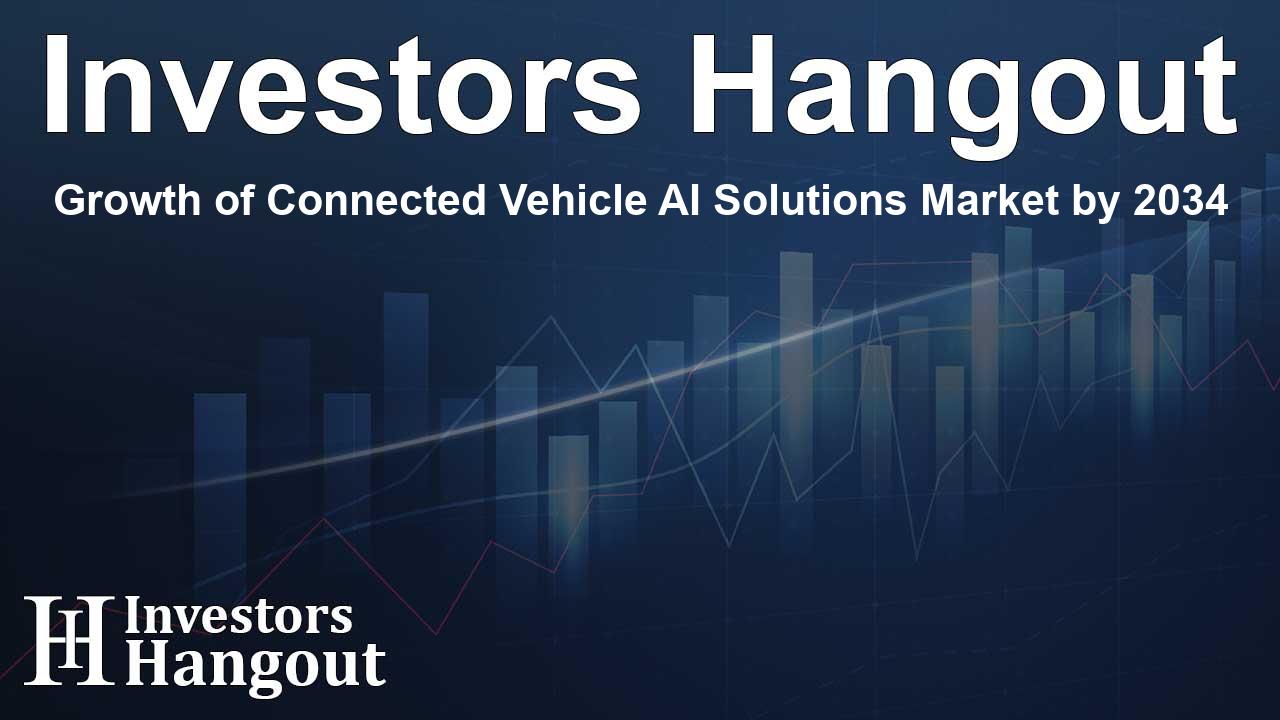Growth of Connected Vehicle AI Solutions Market by 2034

Revolutionizing Transportation: The Connected Vehicle AI Solutions Market
The Connected Vehicle AI Solutions market is entering a remarkable phase of growth, driven by advancements in smart mobility and intelligent transportation systems. Currently valued at USD 8.4 billion, it is projected to soar to an estimated USD 27 billion by 2034. This impressive growth reflects a Compound Annual Growth Rate (CAGR) of approximately 13% from 2025 to 2034, illustrating a quick evolution in AI-driven mobility technologies. The rise can be attributed to a heightened focus on vehicle automation, data-based safety enhancements, and increasing consumer demand for connected driving experiences.
Key Drivers of Market Growth
A significant factor propelling this market is the widespread adoption of AI technologies in smart transportation systems, where real-time communication and automation set new industry standards. Technologies such as Machine Learning, Computer Vision, and Natural Language Processing (NLP) are revolutionizing vehicles, enabling them to diagnose mechanical problems, navigate independently, and respond to drivers’ commands effectively.
The emphasis on road safety and the integration of automated driving systems are also enhancing the demand for AI solutions. Governments and manufacturers are investing heavily in platforms designed to lower accident rates, improve traffic management, and monitor driver behavior more effectively. As urban areas grow denser and traffic management becomes more problematic, AI-driven solutions for predictive maintenance, traffic optimization, and driver assistance systems are becoming essential.
Moreover, the global shift towards electric vehicles (EVs) is paving the way for further AI innovations. EVs, which depend heavily on sophisticated digital systems for monitoring and control, benefit greatly from AI enhancements that improve energy efficiency, optimize routes, and fine-tune system diagnostics.
Technological Innovations Fueling the Market
Machine Learning (ML) is a vital component of market growth, allowing vehicles to learn from various inputs such as driving habits and environmental conditions. This segment is crucial in predictive maintenance and autonomous navigation, enabling vehicles to adjust to changing scenarios and proactively address potential issues, thus showcasing a commanding market share.
Natural Language Processing (NLP) enhances the user experience by facilitating more intuitive interactions with vehicle systems via voice commands. With a rising demand for hands-free operation, NLP is vital in allowing drivers to manage navigation, temperature settings, and entertainment safely and effortlessly.
Computer Vision technology plays a critical role in connected vehicles, supporting applications like obstacle detection, lane departure warnings, and sign recognition. As a backbone for Advanced Driver Assistance Systems (ADAS), it is crucial for providing real-time situational awareness to enhance overall safety.
Applications Transforming Mobility
Autonomous Driving systems are fundamentally rooted in AI, where vehicles perform using minimal human input. This application segment is attracting significant investments and support, especially in regions like North America and parts of Asia, paving the way for successful deployment of self-driving technology.
Traffic Management is being revolutionized by AI-enabled systems that utilize real-time data to optimize traffic flow. Such systems effectively manage road congestion while reducing emissions, contributing to the development of future smart cities. AI's capacity to analyze patterns and dynamically adjust traffic signals is improving the commuting experience.
Predictive Maintenance stands out as a commercially viable application. AI algorithms track the health of vehicle components, enabling fleet operators and individual drivers to anticipate issues before they lead to breakdowns, thereby cutting down on repair expenses and minimizing downtime.
Market Segmentation and Connectivity Types
The market is segmented by technology types, applications, connectivity methods, vehicle types, and end users. Key segments include:
- By Technology Type: Machine Learning, NLP, Computer Vision, Robotics, and Edge Computing
- By Application: Autonomous Driving, Traffic Management, Vehicle-to-Everything (V2X) Communication, Predictive Maintenance, and Driver Assistance Systems
- By Connectivity: Vehicle-to-Vehicle (V2V), Vehicle-to-Infrastructure (V2I), Vehicle-to-Cloud (V2C), and Vehicle-to-Pedestrian (V2P)
- By Vehicle Type: Passenger Cars, Commercial Vehicles, Electric Vehicles (EVs), and Fleets
- By End User: OEMs, Fleet Operators, Insurance Companies, and Consumers
- By Region: North America, Europe, Asia Pacific, Latin America, and Middle East & Africa
Connectivity is crucial for smart vehicle technology, involving forms like V2V, V2I, V2C, and V2P. These technologies enable the creation of a comprehensive Vehicle-to-Everything (V2X) network, central to the goal of achieving fully autonomous transportation.
Challenges and Opportunities Ahead
Despite the numerous opportunities, several challenges could impede market growth:
- Data Privacy: Connected vehicles collect immense amounts of personal data, necessitating stringent security and compliance with regulations to maintain consumer trust.
- Cybersecurity Risks: The reliance on digital platforms invites hacking and risks to system integrity, necessitating significant investments in defense technologies by manufacturers.
- Lack of Standardization: Inconsistent regulations and technological standards across regions and manufacturers hinder large-scale adoption and innovation.
- Component Shortages: Disruptions in supply chains, especially for essential components like semiconductors, are delaying advancements in AI-enabled vehicles.
- Affordability Issues: The high costs associated with advanced AI systems may deter budget-conscious consumers from investing in these evolving technologies.
Nevertheless, the industry is positioned for growth propelled by:
- Consumer Demand: Growing preferences for vehicles with smart features are driving development in innovations such as AI-based parking and lane assist.
- Mobility as a Service (MaaS): Subscription-based models are promoting AI investments for enhanced efficiency in vehicle utilization and personalization.
- Smart City Initiatives: Increasing government investments in smart city frameworks, including intelligent traffic management, are paving the way for AI-driven vehicle solutions.
- Collaborations and Ecosystems: Partnerships among automakers, AI experts, and tech startups are accelerating advancements and expanding market capabilities.
Frequently Asked Questions
What is the projected value of the Connected Vehicle AI Solutions market by 2034?
The market is projected to reach approximately USD 27 billion by 2034.
What are the key technologies contributing to market growth?
Technologies such as Machine Learning, Natural Language Processing, and Computer Vision are key drivers.
What roles do electric vehicles play in this market?
Electric vehicles are crucial as they require advanced digital systems that benefit greatly from AI integration.
What are the major challenges facing the market?
Challenges include data privacy issues, cybersecurity risks, and supply chain disruptions.
How are autonomous driving systems influencing the market?
Autonomous driving systems are significantly boosting investments in AI, making them a foundational aspect of the connected vehicle ecosystem.
About The Author
Contact Evelyn Baker privately here. Or send an email with ATTN: Evelyn Baker as the subject to contact@investorshangout.com.
About Investors Hangout
Investors Hangout is a leading online stock forum for financial discussion and learning, offering a wide range of free tools and resources. It draws in traders of all levels, who exchange market knowledge, investigate trading tactics, and keep an eye on industry developments in real time. Featuring financial articles, stock message boards, quotes, charts, company profiles, and live news updates. Through cooperative learning and a wealth of informational resources, it helps users from novices creating their first portfolios to experts honing their techniques. Join Investors Hangout today: https://investorshangout.com/
The content of this article is based on factual, publicly available information and does not represent legal, financial, or investment advice. Investors Hangout does not offer financial advice, and the author is not a licensed financial advisor. Consult a qualified advisor before making any financial or investment decisions based on this article. This article should not be considered advice to purchase, sell, or hold any securities or other investments. If any of the material provided here is inaccurate, please contact us for corrections.
